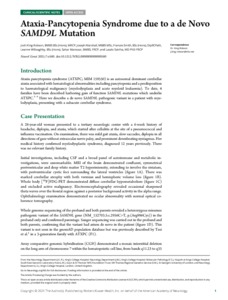Stock, SJ;
Horne, M;
Bruijn, M;
White, H;
Heggie, R;
Wotherspoon, L;
Boyd, K;
Aucott, L;
Morris, RK;
Dorling, J;
et al.
Stock, SJ; Horne, M; Bruijn, M; White, H; Heggie, R; Wotherspoon, L; Boyd, K; Aucott, L; Morris, RK; Dorling, J; Jackson, L; Chandiramani, M; David, A; Khalil, A; Shennan, A; Baaren, G-JV; Hodgetts-Morton, V; Lavender, T; Schuit, E; Harper-Clarke, S; Mol, B; Riley, RD; Norman, J; Norrie, J
(2021)
A prognostic model, including quantitative fetal fibronectin, to predict preterm labour: the QUIDS meta-analysis and prospective cohort study.
Health Technol Assess, 25 (52).
pp. 1-168.
ISSN 2046-4924
https://doi.org/10.3310/hta25520
SGUL Authors: Khalil, Asma
![[img]](https://openaccess.sgul.ac.uk/113642/1.hassmallThumbnailVersion/e580.full.pdf)  Preview |
|
PDF
Published Version
Available under License ["licenses_description_publisher" not defined].
Download (306kB)
| Preview
|
Abstract
BACKGROUND: The diagnosis of preterm labour is challenging. False-positive diagnoses are common and result in unnecessary, potentially harmful treatments (e.g. tocolytics, antenatal corticosteroids and magnesium sulphate) and costly hospital admissions. Measurement of fetal fibronectin in vaginal fluid is a biochemical test that can indicate impending preterm birth. OBJECTIVES: To develop an externally validated prognostic model using quantitative fetal fibronectin concentration, in combination with clinical risk factors, for the prediction of spontaneous preterm birth and to assess its cost-effectiveness. DESIGN: The study comprised (1) a qualitative study to establish the decisional needs of pregnant women and their caregivers, (2) an individual participant data meta-analysis of existing studies to develop a prognostic model for spontaneous preterm birth within 7 days in women with symptoms of preterm labour based on quantitative fetal fibronectin and clinical risk factors, (3) external validation of the prognostic model in a prospective cohort study across 26 UK centres, (4) a model-based economic evaluation comparing the prognostic model with qualitative fetal fibronectin, and quantitative fetal fibronectin with cervical length measurement, in terms of cost per QALY gained and (5) a qualitative assessment of the acceptability of quantitative fetal fibronectin. DATA SOURCES/SETTING: The model was developed using data from five European prospective cohort studies of quantitative fetal fibronectin. The UK prospective cohort study was carried out across 26 UK centres. PARTICIPANTS: Pregnant women at 22+0-34+6 weeks' gestation with signs and symptoms of preterm labour. HEALTH TECHNOLOGY BEING ASSESSED: Quantitative fetal fibronectin. MAIN OUTCOME MEASURES: Spontaneous preterm birth within 7 days. RESULTS: The individual participant data meta-analysis included 1783 women and 139 events of spontaneous preterm birth within 7 days (event rate 7.8%). The prognostic model that was developed included quantitative fetal fibronectin, smoking, ethnicity, nulliparity and multiple pregnancy. The model was externally validated in a cohort of 2837 women, with 83 events of spontaneous preterm birth within 7 days (event rate 2.93%), an area under the curve of 0.89 (95% confidence interval 0.84 to 0.93), a calibration slope of 1.22 and a Nagelkerke R 2 of 0.34. The economic analysis found that the prognostic model was cost-effective compared with using qualitative fetal fibronectin at a threshold for hospital admission and treatment of ≥ 2% risk of preterm birth within 7 days. LIMITATIONS: The outcome proportion (spontaneous preterm birth within 7 days of test) was 2.9% in the validation study. This is in line with other studies, but having slightly fewer than 100 events is a limitation in model validation. CONCLUSIONS: A prognostic model that included quantitative fetal fibronectin and clinical risk factors showed excellent performance in the prediction of spontaneous preterm birth within 7 days of test, was cost-effective and can be used to inform a decision support tool to help guide management decisions for women with threatened preterm labour. FUTURE WORK: The prognostic model will be embedded in electronic maternity records and a mobile telephone application, enabling ongoing data collection for further refinement and validation of the model. STUDY REGISTRATION: This study is registered as PROSPERO CRD42015027590 and Current Controlled Trials ISRCTN41598423. FUNDING: This project was funded by the National Institute for Health Research (NIHR) Health Technology Assessment programme and will be published in full in Health Technology Assessment; Vol. 25, No. 52. See the NIHR Journals Library website for further project information.
| Item Type: |
Article
|
| Additional Information: |
© Queen’s Printer and Controller of HMSO 2021. This work was produced by Stock et al. under the terms of a commissioning contract issued by the Secretary of State for Health and Social Care. This issue may be freely reproduced for the purposes of private research and study and extracts (or indeed, the full report) may be included in professional journals provided that suitable acknowledgement is made and the reproduction is not associated with any form of advertising. Applications for commercial reproduction should be addressed to: NIHR Journals Library, National Institute for Health Research, Evaluation, Trials and Studies Coordinating Centre, Alpha House, University of Southampton Science Park, Southampton SO16 7NS, UK. |
| Keywords: |
FETAL FIBRONECTIN, INDIVIDUAL PARTICIPANT DATA LEVEL META-ANALYSIS, NEONATAL, PARTURITION, PREGNANCY, PRETERM LABOUR, PROGNOSTIC MODEL, 1117 Public Health and Health Services, 0807 Library and Information Studies, 0806 Information Systems, Health Policy & Services |
| SGUL Research Institute / Research Centre: |
Academic Structure > Molecular and Clinical Sciences Research Institute (MCS) |
| Journal or Publication Title: |
Health Technol Assess |
| ISSN: |
2046-4924 |
| Language: |
eng |
| Dates: |
| Date | Event |
|---|
| September 2021 | Published |
|
| Publisher License: |
Publisher's own licence |
| Projects: |
|
| PubMed ID: |
34498576 |
 |
Go to PubMed abstract |
| URI: |
https://openaccess.sgul.ac.uk/id/eprint/113642 |
| Publisher's version: |
https://doi.org/10.3310/hta25520 |
Statistics
Item downloaded times since 14 Sep 2021.
Actions (login required)
 |
Edit Item |



